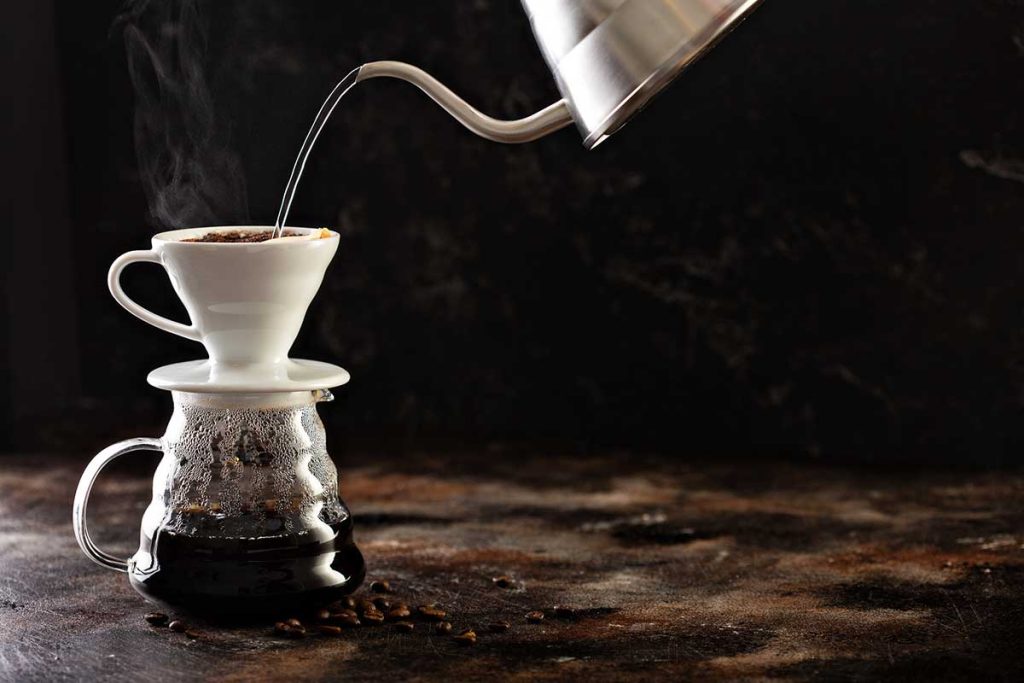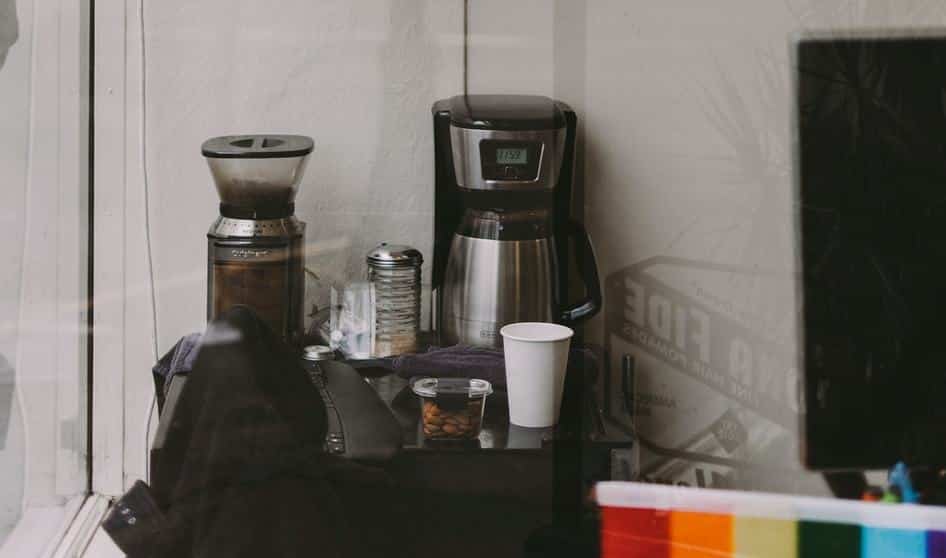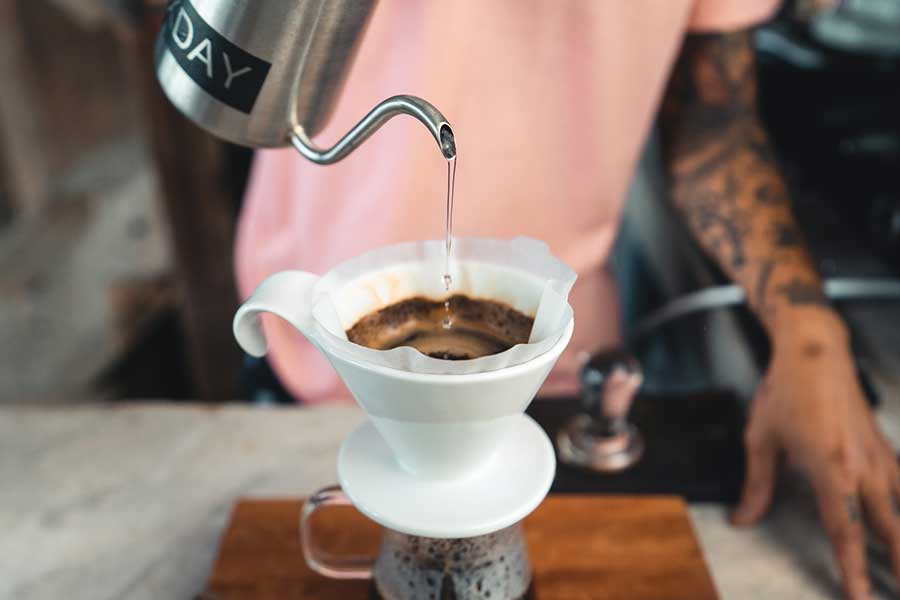What Is Drip Coffee? (Definition, Preparation, and More)

Though the French press and the espresso maker have risen in popularity in recent years, the drip coffee maker is still the brewing method of choice of 41 percent of coffee drinkers in America — that’s way more than any other brewing method!
We take it for granted, and maybe look down on it a bit, but the drip method is classic for a reason. In this article, we’ll dive into this coffee extraction method and what makes it so popular.
What Is Drip Coffee?
Drip coffee — or filter coffee, as some people call it — is a type of coffee made when hot water goes through ground coffee beans enclosed in a filter and then drips into a container. The filter traps the grounds and other unwanted residues.
You can prepare it with the help of a drip coffee machine or by manually pouring hot water over coffee to make what’s popularly known as pour-over coffee. It’s still drip coffee at its core.
Another lesser-known method is the use of drip bags. Since these bags come pre-filled with coffee, all you do is place it in a cup, add water, and then wait a few minutes.
In all these methods, water simply flows through coffee grounds. It’s not pressurized, as is the case with espresso machines, so the texture and aroma of drip coffee will not be the same as that of real espresso. Nonetheless, it still packs a punch. Many of us love its smooth and savory taste.
Now that we all know what drip coffee is, let’s see what makes it different from other coffee brews.
What Makes Drip Coffee Different From Other Coffee Beverages?
What majorly separates drip coffee from other coffee beverages such as espresso is the brewing method and taste. I already hinted to you earlier that drip coffee relies on the power of gravity.
In drip coffee machines, thermally induced pressure sends the water up to the showerhead for brewing. The resulting drink then drips back into a container with the help of gravity. For pour over coffee makers, you simply pour water over medium-fine coffee grounds held in a metal, fabric, or paper filter. Gravity will do the dripping for you.
In both methods, the filters will trap the oils and other residues that would have been present in your brew if you were using a French Press, percolator, or an espresso machine. The result? Coffee that’s smoother and brighter, though not as bitter, rich, or acidic as espresso or coffee from the other two coffee makers.
Brewing drip coffee can take anywhere between 3 to 10 minutes depending on variables such as brew strength, grind size, the number of cups you are making, and the machine model. Most coffee makers prepare coffee within the same period, but espresso machines take a fraction of that time to pull a shot because of higher pressure.
Making drip coffee, however, is uncomplicated, and significantly cheaper, compared to espresso.

How Do You Make Drip Coffee?
You already know by now that drip coffee can be prepared in three different ways:
- Drip coffee machines
- Pour over method
- Drip bags
Let’s dig a little bit deeper into each method to have a better understanding of how to make drip coffee.
1. Drip Coffee Maker
Automatic drip coffee machines first came out in the early 1970s. It’s an American invention and its rise has been phenomenal. Today, Americans love it more because of its simplicity. Here’s how they work.
Add clean water to the reservoir, plug in the machine, turn it on, and press brew. Some have settings where you can schedule the brew time, select brew strength, and choose cup capacity. It’s as simple as that. Your involvement is limited to loading coffee and water and pressing the brew button.
Remember to take good care of your drip coffee maker so it can serve you without fail. Particularly, be sure to clean and descale it as recommended by the manufacturer.
Some of the best drip coffee machines on the market today include:
- Cuisinart DCC-3000 Coffee-on-Demand 12-Cup Programmable Coffeemaker
- Technivorm Moccamaster 79112 KBT Coffee Brewer
- Breville BDC450BSS Precision Brewer Thermal, Coffee Maker
2. Pour Over Method
Pour over coffee brewing is a method mostly preferred by coffee connoisseurs because it gets one more involved in the brewing process. Besides a pour over coffee maker, you are going to need a burr grinder and a gooseneck kettle. I’ll take you through the process really quickly.
Step 1: Grind your freshly roasted coffee beans to medium size.
Step 2: Add the grounds to the filter or coffee basket.
Step 3: Boil water to between 195 and 205 degrees Fahrenheit.
Step 4: Add the water to the grounds in a slow and spiral manner using your gooseneck kettle.
Step 5: Allow brewing to take place (3-5 minutes).
Tip: Keep the coffee to water ratio at 1:17 for the best results.
Since you are the one grinding the beans, adding the water, controlling its flow, and timing the brewing, the outcome majorly depends on you. You have to get each of these steps right in order to make a great-tasting cup of coffee.

Pour over coffee makers you can count on for tasty drip coffee include:
3. Drip Bag
Drip bags trace their roots back to the early 80s, and Tokyo hotels were the first to embrace them. Instead of automatic coffee makers, the bags would be placed in hotel rooms. The only other things you would need were a mug and hot water.
Fast forward to today, and drip bags are still in use in most places around the world, particularly in Asian countries. It’s not as popular in the US, but you can still find them in select coffee shops and online platforms.
Preparing coffee with drip bags follows the same procedures as pour over coffee. You heat the water and pour it into a mug, then wait a few minutes for the coffee to be extracted from the drip bag. Be careful not to use super hot water or pour the water straight into the bag, because that might tear the bag and disperse the grounds into your brew.
Frequently Asked Questions
Why is drip coffee better for you?
Drip coffee’s most significant benefit is the ease of preparation, no matter the brewing method. Another big advantage is that you can brew up to 12 cups in a single brew cycle. What’s more, drip coffee is also one of the most affordable coffee brews to make.
Healthwise, drip coffee won’t affect your cholesterol level the same way espresso will because it has less caffeine and oils. Studies show that both compounds can raise your cholesterol levels.
Cholesterol issues aside, drip coffee offers the same benefits as other coffee beverages. Top on the list is an increase in energy. Others include aiding in weight loss, elevating your mood, improving mental focus, and reducing the risk of diseases.
Can you make iced coffee with drip coffee?
Yes, you can ice your drip coffee to make a cold coffee beverage perfect for summer. It’s a simple process.
You can either pour your hot brew directly over a glass of ice or add ice to your mug or carafe and let your brew drip into it. Before doing that, just make sure your coffee is stronger than usual because the ice will dilute its strength and taste.
Another way to do this is to freeze your brewed coffee into ice cubes. This saves you the need to brew stronger coffee because you will have preserved its strength and taste by eliminating the added water from melting ice cubes.
Do not put the coffee in a refrigerator because it will oxidize and eventually lose its taste.
Is drip coffee good with milk?
Yes, you can add milk to your drip coffee. It’s the surest way to give your drink a creamier texture and more flavor. Milk can also mask unpleasant flavors and minimize astringency. Use heated milk to maintain the temperature of your coffee, or cold milk to cool the coffee without adding ice cubes which will dilute your drink.
Do not make the mistake of using milk instead of water to brew, though. This can ruin your drip coffee machine and lead to the growth of bacteria in your coffee maker.
What’s Dripping?
In summary, drip coffee is coffee prepared by pouring water over coffee grounds. All drip coffee brewing methods follow this basic principle. Compared to other coffee preparations, it’s the simplest to make.
It’s up to you to decide which method to use. Average coffee drinkers prefer coffee drip machines because there’s less involvement in the brewing process. It’s a brew-and-go affair.
Pour-over coffee makers, on the other hand, are more hands-on. You will have to do every step manually, except the brewing. It may be uninviting if you are new to the coffee world but for a seasoned coffee user, this is the method that guarantees you a better brewing experience.
That’s all you should ever need to know about what drip coffee is.
Owen is a writer and editor at Caffe Streets who considers himself a coffee fanatic. He spends his time researching and testing different coffee beans and brewing methods and sharing what he learns with others.







